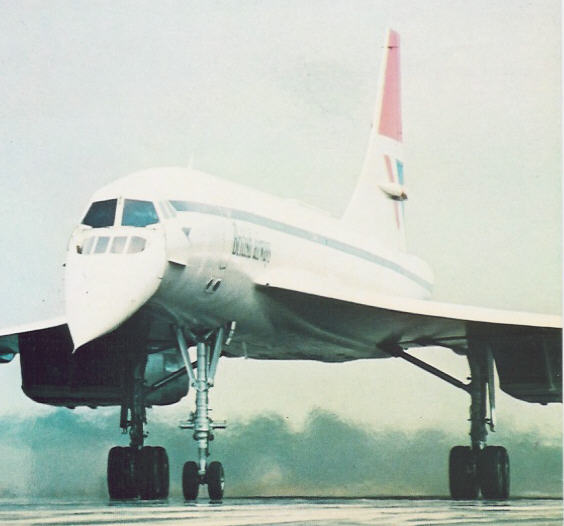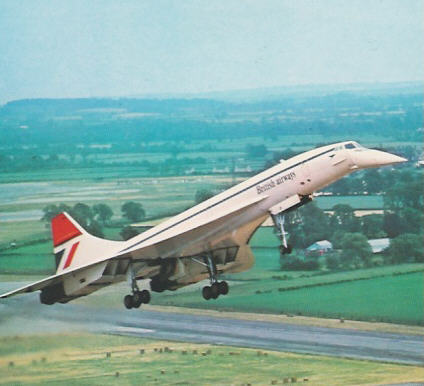

Super Sonic Transport (1977)
The Flight of the Concorde Following a business trip in Europe, I changed my return reservations in London to fly home on the Concorde. The premium was $ 100 over the price of my first class ticket on Northwest. . . a small price to pay to return home to my wife a few hours earlier after our two week separation. |
 |
Concorde Landing Concorde Taking Off
You could tell it was going to be a different kind of experience from the moment you walked into the waiting room at Heathrow Airport . . . not only by the bustling attendants, who took your coat, offered you champagne, caviar and hors d’oeuvres but more by the type of people who shared the exclusive Concorde waiting room facilities. The unusually high proportion of sheiks, East Indians and black Africans gave some indication that the Concorde route has greater appeal to those in diplomatic circles than the ordinary traveling businessman due, at least in part, to the fact that the trans-Atlantic routes fly only into our nation’s capital.
The first impression of the plane from the waiting room window is that it is smaller than expected. It is probably the smallest commercial jet aircraft in service. The passenger capacity is only 100 people compared to the 350 passenger carrying capacity of the jumbo jet. And, of course, the most distinctive features of the Concorde aircraft are the drooped nose and the location of the wings which are not at mid-fuselage as with most planes but well back on the aircraft in a unique delta-wing configuration.
It was with a considerable sense of excitement that I finally boarded the aircraft. My excitement was dampened only in part by a get-acquainted conversation with my seat companion who, when queried if it was first flight, told me "No" and that he had traveled Concorde maybe 20-25 times thus far.
My excitement continued during take-off as the pilot applied his afterburners for a period of about sixty seconds in order to achieve subsonic cruising speed. We proceed to fly of the British Isles at about 25,000 feet and 600 miles per hour. Just as soon as the west coast of England appeared below the plane, the pilot announced that he was going to kick in his afterburners again. There was a slightly noticeable pressure in your seat back as the plane then proceeded to accelerate and climb.
Within less than a minute, we hit the sound barrier. There is no sensation whatsoever aboard the aircraft. In fact, the only indication of speed is a digital indicator in the front of the passenger cabin showing air speed. As the indicator hit Mach 1, the steward rose and began his stroll down the aisle soliciting dinner selections.
The progress on up to maximum velocity was slower than I expected . . . a function of altitude and fuel load. It was probably ninety minutes into the flight that we finally approached Mach 2 . . . twice the speed of sound. My traveling companion had long since dozed off but I did note a number of people in the cabin with their eyes fixed on the digital indicator as it hit Mach 2.00. I had to suppress the urge to applaud. At that point, we were flying at 1,230 miles per hour or 22 miles per minute . . . or one mile in just under 2 ½ seconds.
At that point we were flying at 56,000 feet above the earth and I was feeling a bit like John Glenn. Is it any different from subsonic flight at half that altitude? Yes, in a couple of ways: the curvature of the earth is certainly much more pronounced from that altitude, the sky is darker due to the lower density of the atmosphere and the windows felt hot to my touch. Maybe it was just the sun. But, in fact, the skin temperature of the aircraft at that speed ranges from 170 to 230 degrees F.
The door to the flight deck was open and I read this as an invitation to stick my head in. I found the British crew quite willing to chat. They even let me take a few photographs in the cockpit. One fact from our conversation I found particularly interesting is that the effective capacity of the plane is lower in the summer than in the winter due to the lower air temperatures and consequent effect on lift. Whereas in the winter British Airways books to the full 100 passenger seating capacity, in the summer they accept reservations for only 75-80 seats depending on expected air temperatures.
From the flight deck, you also get a look at the unique nose cone arrangement. In place for supersonic flight, it presents a clean aerodynamic shape by covering and fairing off the windshields. On take-off and landing, the nose is dropped to provide the crew with greater vision (by 17.5° on landing and by 5° on take-off).
The crew was also anxious to talk about possibilities of extending landing rights to New York City, a fact crucial to the commercial success of the Concorde. The decision had just be delayed a few days earlier. The were encouraged, however, by a plan whereby a Braniff crew would take over the aircraft in Washington and fly it to Texas and back at sub-sonic speeds. Even flying the Concorde over land at Mach 0.95, it would still have a time advantage over other subsonic aircraft.
How about the food service and comfort? Food and service are as good as but certainly no better than other transatlantic flights. The comfort is less, the seats are smaller, the aisles are more narrow and compared to the spaciousness of the first class 747 lounge, it is like the difference between a Volkswagen and a limousine. But, in compensation, you arrive at your destination before your legs have time to become cramped. It seemed we had just hit the maximum speed of Mach 2.02 when the pilot announced that we were in descent for landing at Washington’s Dulles Airport.
We left London at 1:00 p.m. (GMT). We arrived at Dulles at 11:50 am (EST) for an elapsed time of three hours and fifty minutes. The pilot apologized for head winds. He said we should have made it in three hours and forty five minutes. I can’t help wondering what our old Genoa neighbor, Mr. Columbus, would have thought of this transatlantic crossing.
Would I fly the Concorde again? Sure. Can I justify the extra cost. No, not in any rational way. Does supersonic flight represent progress? Yes, without question. Is the Concorde here to stay or destined for extinction? I think that bird will be flying for a long time. (Note: Concorde made it's final flight on October 24, 2003 victim of its continuing economic losses and the era of supersonic, commercial flight came to an end).